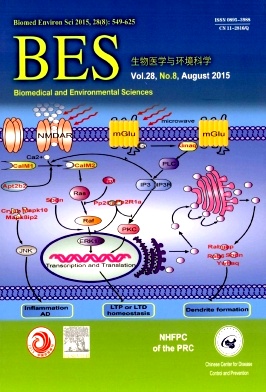Mutagenic and Estrogenic Effects of Organic Compounds in Water Treated by Different Processes:A Pilot Study
doi: 10.3967/bes2015.081
-
Key words:
- Water treatment processes /
- Organic compounds /
- Yeast estrogen screen (YES assay) /
- Ames test /
- GC-MS
Abstract: Objective In this study, a pilot-scale investigation was conducted to examine and compare the biotoxicity of the organic compounds in effluents from five treatment processes (P1-P5) where each process was combination of preoxidation (O3), coagulation, sedimentation, sand filtration, ozonation, granular activated carbon, biological activated carbon and chlorination (NaClO).
Methods Organic compounds were extracted by XAD-2 resins and eluted with acetone and dichlormethane (DCM). The eluents were evaporated and redissolved with DMSO or DCM. The mutagenicity and estrogenicity of the extracts were assayed with the Ames test and yeast estrogen screen (YES assay), respectively. The organic compounds were detected by GC-MS.
Results The results indicated that the mutation ratio (MR) of organic compounds in source water was higher than that for treated water. GC-MS showed that more than 48 organic compounds were identified in all samples and that treated water had significantly fewer types and concentrations of organic compounds than source water.
Conclusion To different extents, all water treatment processes could reduce both the mutagenicity and estrogenicity, relative to source water. P2, P3, and P5 reduced mutagenicity more effectively, while P1 reduced estrogenicity, most effectively. Water treatment processes in this pilot plant had weak abilities to remove Di-n-butyl phthalate or 1, 2-Benzene dicarboxylic acid.
| Citation: | LU Yi, LYU Xue Min, XIAO San Hua, YANG Xiao Ming, WANG Ya Zhou, TANG Fei. Mutagenic and Estrogenic Effects of Organic Compounds in Water Treated by Different Processes:A Pilot Study[J]. Biomedical and Environmental Sciences, 2015, 28(8): 571-581. doi: 10.3967/bes2015.081 |







 Quick Links
Quick Links
 DownLoad:
DownLoad: